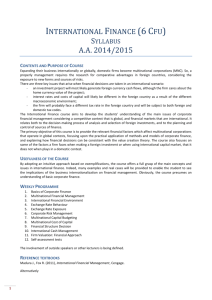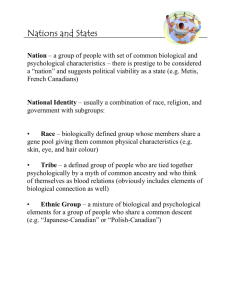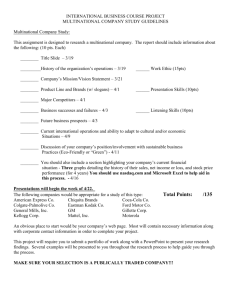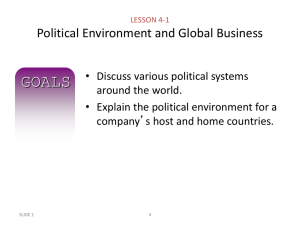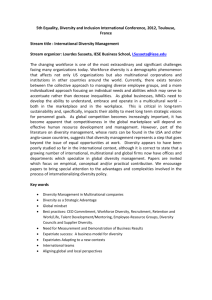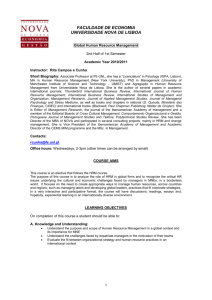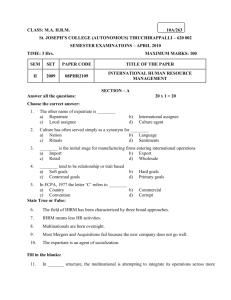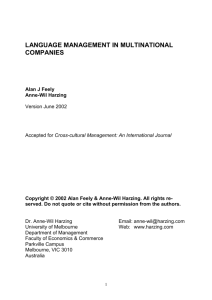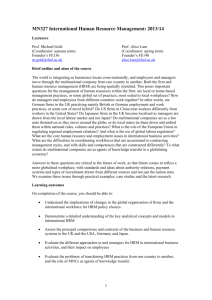OLG 122: INTERNATIONAL HUMAN RESOURCE MANAGEMENT
advertisement
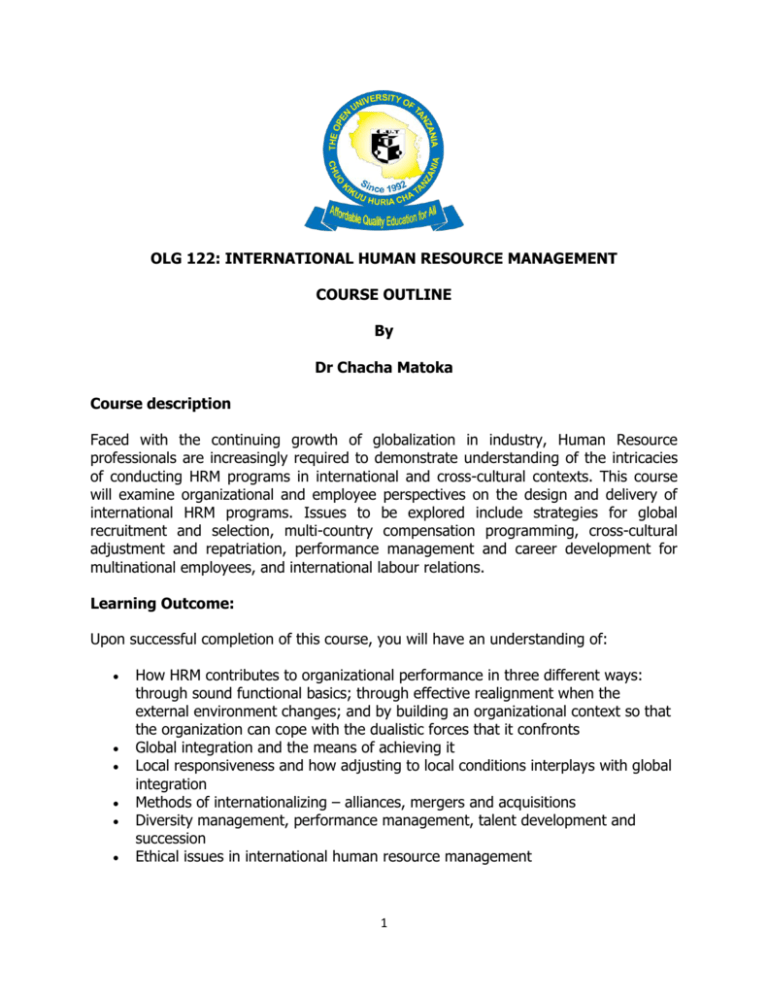
OLG 122: INTERNATIONAL HUMAN RESOURCE MANAGEMENT COURSE OUTLINE By Dr Chacha Matoka Course description Faced with the continuing growth of globalization in industry, Human Resource professionals are increasingly required to demonstrate understanding of the intricacies of conducting HRM programs in international and cross-cultural contexts. This course will examine organizational and employee perspectives on the design and delivery of international HRM programs. Issues to be explored include strategies for global recruitment and selection, multi-country compensation programming, cross-cultural adjustment and repatriation, performance management and career development for multinational employees, and international labour relations. Learning Outcome: Upon successful completion of this course, you will have an understanding of: How HRM contributes to organizational performance in three different ways: through sound functional basics; through effective realignment when the external environment changes; and by building an organizational context so that the organization can cope with the dualistic forces that it confronts Global integration and the means of achieving it Local responsiveness and how adjusting to local conditions interplays with global integration Methods of internationalizing – alliances, mergers and acquisitions Diversity management, performance management, talent development and succession Ethical issues in international human resource management 1 TOPIC ONE: INTRODUCTION TO INTERNATIONAL HUMAN RESOURCE MANAGEMENT: THE CONTEXT Subtopics: 1.1 International business and International Human Resource Management 1.1. The internationalization of business 1.2. The internationalization of Human Resource Management TOPIC TWO: Strategic International Human Resource Management 2.1. Strategic IHRM 2.2. Evolution of the multinational enterprise 2.3. A model for Strategic IHRM TOPIC THREE: Organizational structure and design of the multinational enterprise 3.1. Global organization design: an introduction 3.2. IHRM and organizational design 3.3. Designing the multinational enterprise 3.4. It’s more than formal structure 4 5 T00KKKKKKKK TOPIC FOUR: Cross-border mergers and acquisitions, international joint Ventures and alliances 4.1. Cross-border M&As, international joint ventures, and alliances 4.2. Managing the cross-border merger or acquisition 4.3. International joint ventures 4.4. Alliances and partnerships TOPIC FIVE: Country culture and MNE culture 5.1. The most important issue: culture 5.2. Cultural attitudes and values and management practices 5.3. Impact of culture on IHRM 5.4. Research in IHRM TOPIC SIX: Global employment law and labor relations 6.1. Global employment law and enforcement 6.2 Comparative employment law 6.3. Extraterritorial application of national law (with special attention 6.4. To the US and Tanzania) 6.5. Application of national law to local foreign-owned enterprises 2 (With special attention to the US and Tanzania) 6.6. Union and labor relations 6.7. Immigration law 6.8. MNE employment policy and practice TOPIC SEVEN: Global ethics and labor standards 7.1. The ethics of HR decision making in foreign operations: a general perspective 7.2. International standards 7.3. Balancing the extremes: suggested guiding principles TOPIC EIGHT: Global workforce planning, forecasting, and staffing the multinational enterprise 8.1. Global workforce planning and forecasting 8.2. Staffing the multinational enterprise: an introduction 8.3. Global staffing choices: implications for multinational enterprises TOPIC NINE: Staffing the global enterprise: selection of international assignees 9.1. International assignees and international assignments 9.2. Staffing with international assignees 9.3. Successful expatriation 9.4. Immigration law TOPIC TEN: Training and management development in the global enterprise 10.1. Training in the global enterprise 10.2. Management development in the global enterprise TOPIC ELEVEN: Global compensation, benefits, and taxes 11.1. Compensation and benefits for expatriates 11.2. Designing a compensation strategy for multinationals TOPIC TWELVE: International performance management for international assignees and foreign managers 12.1. Purposes and roles of international performance management 12.2. Challenges to the effectiveness of the IPM system 12.3. Managing the IPM system 12.4. International assignee and foreign manager development 12.4. Senior managers’ attitudes about international performance management 12.5. Overcoming IPM challenges 12.6. Characteristics of effective IPM systems: guidelines 3 TOPIC THIRTEEN: Health, safety, and crisis management in the global enterprise 13.1. Employee health and safety around the world 13.2. Health and safety for international assignees REFERENCES: Anne-Wil K Harzing and Ashly Pinnington (2010)International Human Resource Management by Anne-Wil Harzing and Ashly H. Pinnington (2011) International Human Resource Management Ashly Pinnington, Dr Anne-Wil K Harzing and Anne-Wil K Harzing (2012) International Human Resource Management Chris Brewster, Paul Sparrow and Guy Vernon ( 2011) 920International Human Resource Management Chris Rees and Tony Edwards (11 Nov 2010) International Human Resource Management: Globalization, National Systems and Multinational Companies Dennis Briscoe, Dennis R. Briscoe, Randall S. Schuler and Randall Schuler (2008) International Human Resource Management: Policy and Practice for Multinational Enterprises (Global HRM) by Peter J. Dowling, Marion Festing and Sr. Allen D. Engle ( 2007) International Human Resource Management30 1 2 3 4 4

